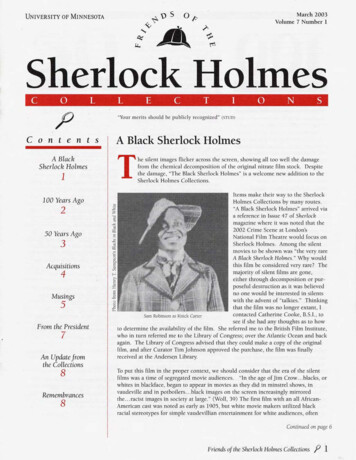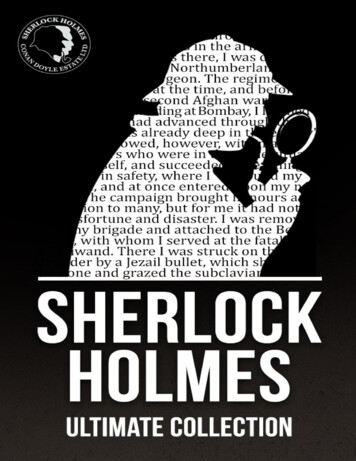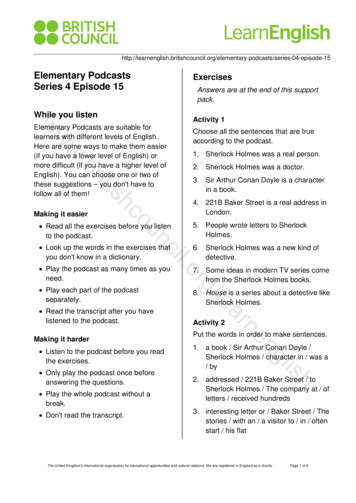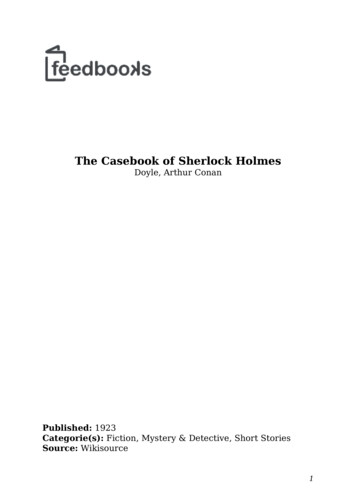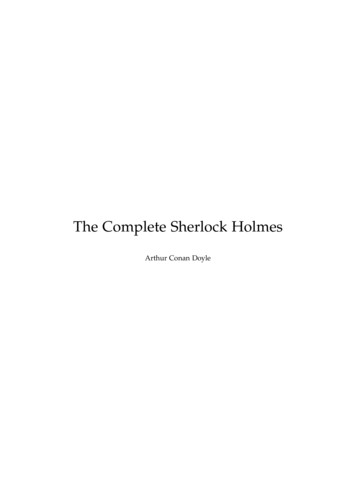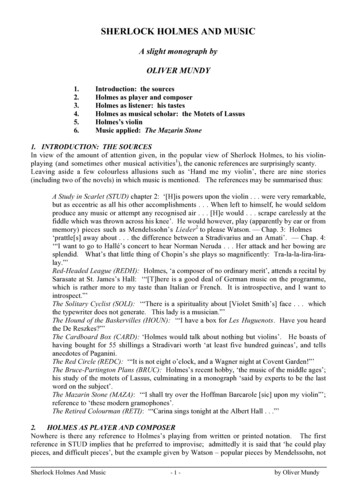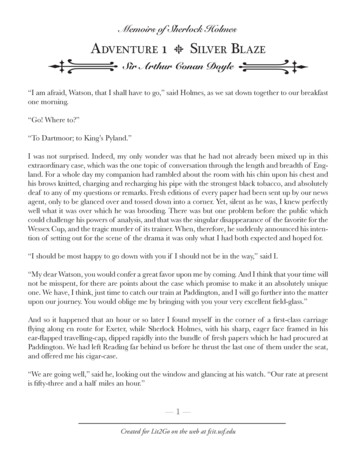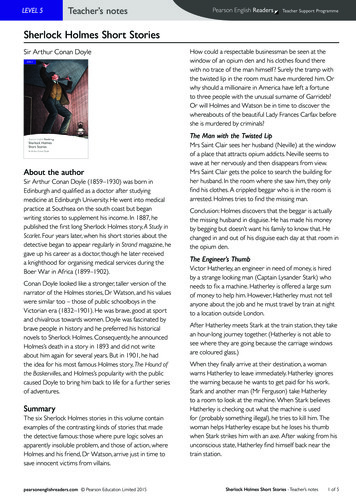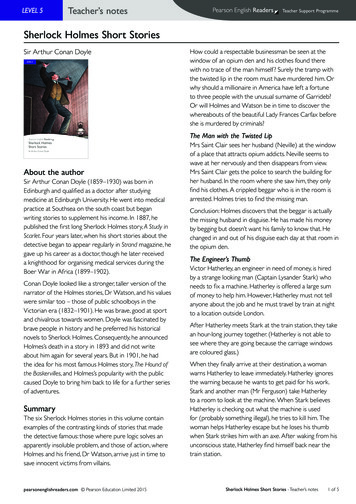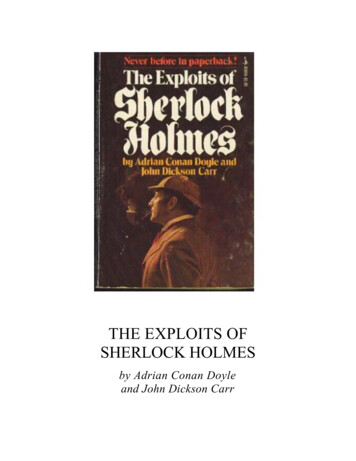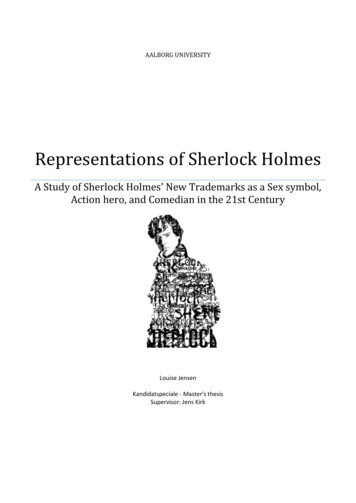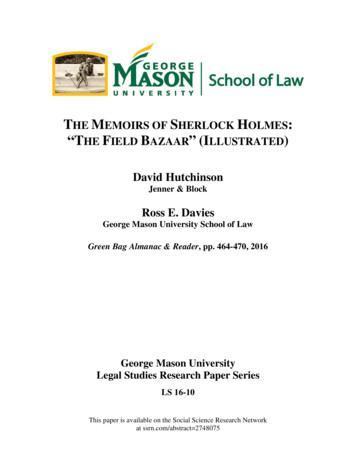
Transcription
THE MEMOIRS OF SHERLOCK HOLMES:“THE FIELD BAZAAR” (ILLUSTRATED)David HutchinsonJenner & BlockRoss E. DaviesGeorge Mason University School of LawGreen Bag Almanac & Reader, pp. 464-470, 2016George Mason UniversityLegal Studies Research Paper SeriesLS 16-10This paper is available on the Social Science Research Networkat ssrn.com/abstract 2748075
THE MEMOIRS OF SHERLOCK HOLMES“THE FIELD BAZAAR”ILLUSTRATEDstory by A. Conan Doyleillustrations by David Hutchinsonintroduction by Ross E. DaviesWINTRODUCTION:PICTURING HOLMES AND WATSONould The Strand Magazine have published “The Field Bazaar” —that odd little 1896 Sherlock Holmes and John Watson vignette —if Arthur Conan Doyle had opted not to give it to The Student magazineat Edinburgh University?I am pretty sure The Strand would have taken the story, gladly. HerbertGreenhough Smith, editor-in-fact of The Strand, liked tales of SherlockHolmes.1 He had published and would continue to publish most of theoriginal Holmes stories. Besides, they were quite profitable. Accordingto Conan Doyle scholar Daniel Stashower, “Conan Doyle’s name carriedsuch weight that it could add 100,000 copies to The Strand’s monthly circulation figures.”2 (Of course, Conan Doyle would not have given thestory to anyone other than The Student. It was a charitable gift, writtenjust for the occasion in support of Edinburgh University’s real-life fieldbazaar.3)The Strand did not publish “The Field Bazaar” in 1896, nor did it everrepublish the story. But what if it had? For starters, the story would haveenjoyed a larger readership.4See page iv above; see also DANIEL STASHOWER, TELLER OF TALES: THE LIFE OF ARTHURCONAN DOYLE 121-22 (1999).2 Id. at 125.3 The Field Bazaar, in THE RETURN OF SHERLOCK HOLMES, App. I at 319-20 (Oxford 1993)(Richard Lancelyn Green ed.) (introductory note by Green); see also J.I. MACPHERSON,TWENTY-ONE YEARS OF CORPORATE LIFE AT EDINBURGH UNIVERSITY 29-30, 44 (1905).4 See REGINALD POUND, MIRROR OF THE CENTURY: THE STRAND MAGAZINE 1891-1950 at 32(1966).12016 GREEN BAG ALMANAC & READER 464
THE FIELD BAZAAR, ILLUSTRATEDSecond, “The Field Bazaar” would havebeen illustrated (it was not in The Student),and the pictures would have been drawnby Sidney Paget. Smith would surely havemade sure of that. He had enlisted Pagetto illustrate the Holmes Adventures andMemoirs series (1891-93), and would laterdo the same for The Hound of the Baskervilles (1901-02) and the Return series (190304). In the 1890s and early 1900s, Paget’sillustrations were for many readers the truepictures of Holmes and Watson — andthey remain influential.5Third, and perhaps most interestingly, if “The Field Bazaar” hadsomehow found its way into The Strand, it might have become something more than the obscurity that it is today. It has long been regardedby experts not as a canonical Sherlock Holmes story, but as a pastiche. Inother words, the “The Field Bazaar” is not a true glimpse of the worldConan Doyle created (or the life Watson lived), but, rather, a mere echo(a humorous, exaggerated one) created in the style of a genuine SherlockHolmes story.6 Might the combination of (a) contemporary publicationin close proximity to classic Holmes stories (in their primary home periodical) with (b) contemporary pictures by Paget (the primary early illustrator of those stories) have been sufficient to tilt some experts toward amore favorable view of canonical status for the story?7See Glen S. Miranker, Sidney Paget’s Sherlock Holmes, in NICHOLAS UTECHIN AND CATHERINECOOKE, SHERLOCK HOLMES: THE MAN WHO NEVER LIVED AND WILL NEVER DIE 34 (2015);CHRISTOPHER REDMOND, SHERLOCK HOLMES HANDBOOK 84-88 (2d ed. 2009); see also GeorgeNewnes, The One Hundredth Number of “The Strand Magazine,” 17 THE STRAND 363 (Apr. 1899);POUND, MIRROR OF THE CENTURY at 42-43.6 Questioning the canonical status of this or that Sherlock Holmes story is a thoroughlyrespectable exercise in the admirably open-minded community of Holmes scholars. SeeLeslie S. Klinger, Why We Write, in THE GRAND GAME: A CELEBRATION OF SHERLOCKIANSCHOLARSHIP VOLUME TWO 1960-2010 at 1, 2 (2012); Michael J. Riezenman, Thoughts on theCanonicity of The Sign of the Four, 60 BAKER STREET J. 12 (Summer 2010); see also ArthurConan Doyle, The Reigate Puzzle (1893) (Sherlock Holmes: “Now I make a point of neverhaving any prejudices, and of following docilely wherever fact may lead me . . . .”); Bernard Davies, Introduction, in THE SHERLOCK HOLMES REFERENCE LIBRARY: THE SIGN OF FOURxi, xi-xii (2004) (Leslie S. Klinger, ed.).7 Cf. DONALD A. REDMOND, SHERLOCK HOLMES AMONG THE PIRATES: COPYRIGHT AND CONAN5ALMANAC & READER465
THE FIELD BAZAAR, ILLUSTRATEDIt is, alas, too late for that thought to be more than speculative. Pagetdied in 1908. The last Paget-illustrated Holmes story was “The Adventureof the Second Stain,” published in the October 1904 issue of The Strand.8So, we will never know how Paget would have portrayed the Holmes andWatson of “The Field Bazaar.” Would they have been clownish caricaturesof themselves, or would Paget have played it straight and sober with theimagery?9 The former would have been a fairly unambiguous signal thatthe story was a pastiche, the latter, not so clear.In fact, “The Field Bazaar” did not appear anywhere other than TheStudent until the mid-1930s.10 Since then it has floated on the margins ofthe world of Holmes and Watson, denied not only canonical status, butalso original illustration. It has been, really, an orphan work.Canonizing is outside the scope of the Green Bag’s authority (and interest, and competence), but illustrating and publishing are not. So, havingboth some sympathy for “The Field Bazaar” and some appreciation forthe story it tells — whether canonical or comical, it is fun to read — theGreen Bag has enlisted an excellent modern illustrator to illuminate it.David Hutchinson is well-suited to the task of adding pictures to“The Field Bazaar” for a Green Bag version of this entertaining tidbit forlawyers. He is both a skilled amateur artist and a successful practicinglawyer.11 His offerings here are, first, a respectfully derivative salute toPaget (see page 467 below) and, second, an entirely original, Pagetinspired portrayal of a contemplative Watson (page 469). We hope thatHutchinson’s best efforts to bring the words of “The Field Bazaar” tovisual life — combined with our best efforts to bring these old wordsand new pictures together tastefully — bring you new pleasure in thisamusing, anomalous sidelight on Sherlock Holmes and John Watson:DOYLE IN AMERICA 1890-1930, at 18 (1990) (wondering how American views of SherlockHolmes might have been affected “if the ‘Adventures’ as published in American newspapershad had the Paget illustrations”).8 In the early 20th century, the English Paget was succeeded by the American Frederic DorrSteele, whose first-rate illustrations of Holmes stories appeared in Collier’s Weekly and othermagazines. See REDMOND, SHERLOCK HOLMES HANDBOOK at 84, 88-90.9 Cf. VINCENT STARRETT, THE PRIVATE LIFE OF SHERLOCK HOLMES 169 (1934) (“Frederic DorrSteele, the artist, also has done a parody or two in prose, for the delectation of his fellowmembers of the Players . . . .”).10 See Cattleya M. Concepcion, Arthur Conan Doyle’s “The Field Bazaar”: A Bibliography, page443 above.11 See jenner.com/people/DavidHutchinson.4662016 GREEN BAG
THE FIELD BAZAAR, ILLUSTRATEDHe smiled as he took his slipper from the mantelpiece and drew from it enough shagtobacco to fill the old clay pipe with which he invariably rounded off his breakfast.(Based on Sidney Paget illustrations for “The Adventure of the Copper Beeches”and “The Adventure of the Stockbroker’s Clerk.”)THE FIELD BAZAAR“I SHOULD certainly do it,” said Sherlock Holmes.I started at the interruption, for my companion had been eating hisbreakfast with his attention entirely centred upon the paper which waspropped up by the coffee pot. Now I looked across at him to find hiseyes fastened upon me with the half-amused, half-questioning expressionwhich he usually assumed when he felt he had made an intellectual point.“Do what?” I asked.He smiled as he took his slipper from the mantelpiece and drew fromit enough shag tobacco to fill the old clay pipe with which he invariablyrounded off his breakfast.ALMANAC & READER467
THE FIELD BAZAAR, ILLUSTRATED“A most characteristic question of yours, Watson,” said he. “You willnot, I am sure, be offended if I say that any reputation for sharpnesswhich I may possess has been entirely gained by the admirable foilwhich you have made for me. Have I not heard of debutantes who haveinsisted upon plainness in their chaperones? There is a certain analogy.”Our long companionship in the Baker Street rooms had left us onthose easy terms of intimacy when much may be said without offence.And yet I acknowledge that I was nettled at his remark.“I may be very obtuse,” said I, “but I confess that I am unable to seehow you have managed to know that I was . . . I was . . .”“Asked to help in the Edinburgh University Bazaar.”“Precisely. The letter has only just come to hand, and I have not spokento you since.”“In spite of that,” said Holmes, leaning back in his chair and puttinghis finger tips together, “I would even venture to suggest that the objectof the bazaar is to enlarge the University cricket field.”I looked at him in such bewilderment that he vibrated with silentlaughter.“The fact is, my dear Watson, that you are an excellent subject,” saidhe. “You are never blasé. You respond instantly to any external stimulus.Your mental processes may be slow but they are never obscure, and Ifound during breakfast that you were easier reading than the leader inthe Times in front of me.”“I should be glad to know how you arrived at your conclusions,” said I.“I fear that my good nature in giving explanations has seriouslycompromised my reputation,” said Holmes. “But in this case the train ofreasoning is based upon such obvious facts that no credit can be claimedfor it. You entered the room with a thoughtful expression, the expressionof a man who is debating some point in his mind. In your hand you helda solitary letter. Now last night you retired in the best of spirits, so it wasclear that it was this letter in your hand which had caused the change inyou.”“This is obvious.”“It is all obvious when it is explained to you. I naturally asked myselfwhat the letter could contain which might have this effect upon you. Asyou walked you held the flap side of the envelope towards me, and Isaw upon it the same shield-shaped device which I have observed uponyour old college cricket cap. It was clear, then, that the request came from4682016 GREEN BAG
THE FIELD BAZAAR, ILLUSTRATED“. . . you laid down the letter beside your plate with the address uppermost, and youwalked over to look at the framed photograph upon the left of the mantelpiece.”Edinburgh University — or from some club connected with the University. When you reached the table you laid down the letter beside yourplate with the address uppermost, and you walked over to look at theframed photograph upon the left of the mantelpiece.”It amazed me to see the accuracy with which he had observed mymovements. “What next?” I asked.“I began by glancing at the address, and I could tell, even at the distance of six feet, that it was an unofficial communication. This I gatheredfrom the use of the word ‘Doctor’ upon the address, to which, as a Bachelor of Medicine, you have no legal claim. I knew that University officials are pedantic in their correct use of titles, and I was thus enabled tosay with certainty that your letter was unofficial. When on your return tothe table you turned over your letter and allowed me to perceive that theenclosure was a printed one, the idea of a bazaar first occurred to me. Ihad already weighed the possibility of its being a political communication, but this seemed improbable in the present stagnant conditions ofpolitics.“When you returned to the table your face still retained its expression, and it was evident that your examination of the photograph hadALMANAC & READER469
THE FIELD BAZAAR, ILLUSTRATEDnot changed the current of your thoughts. In that case it must itself bearupon the subject in question. I turned my attention to the photograph,therefore, and saw at once that it consisted of yourself as a member ofthe Edinburgh University Eleven, with the pavilion and cricket-field inthe background. My small experience of cricket clubs has taught me thatnext to churches and cavalry ensigns they are the most debt-laden thingsupon earth. When upon your return to the table I saw you take out yourpencil and draw lines upon the envelope, I was convinced that yourwere endeavouring to realise some projected improvement which was tobe brought about by a bazaar. Your face still showed some indecision, sothat I was able to break in upon you with my advice that you should assist in so good an object.”I could not help smiling at the extreme simplicity of his explanation.“Of course, it was as easy as possible,” said I.My remark appeared to nettle him.“I may add,” said he, “that the particular help which you have beenasked to give was that you should write in their album, and that youhave already made up your mind that the present incident will be thesubject of your article.”“But how —— !” I cried.“It is as easy as possible,” said he, “and I leave its solution to yourown ingenuity. In the meantime,” he added, raising his paper, “you willexcuse me if I return to this very interesting article upon the trees ofCremona, and the exact reasons for their pre-eminence in the manufacture of violins. It is one of those small outlying problems to which I amsometimes tempted to direct my attention.[”]12 The first of the stories collected here — “The Field Bazaar,”written in 1896 — reflects what might be termed an uncharacteristic surge of school spirit for the University ofEdinburgh, where Conan Doyle had received his medicaltraining twenty years earlier.Daniel Stashower, Introduction, inThe Apocrypha of Sherlock Holmes xii(2009) (Leslie Klinger ed.)12See Ross E. Davies, The Quotation Mark Puzzle, page 511 below.4702016 GREEN BAG
6 Questioning the canonical status of this or that Sherlock Holmes story is a thoroughly respectable exercise in the admirably open-minded community of Holmes scholars. See Leslie S. Klinger, Why We Write, in THE GRAND GAME: A CELEBRATION OF SHERLOCKIAN SCHOLARSHIP VOLUME TWO 1960-2010 at 1, 2 (2012); Michael J. Riezenman, Thoughts on the
